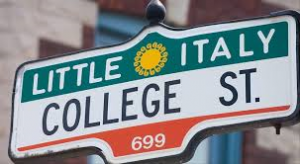Say Si to Little Italy
 Little Italy, that area that is sometimes referred to as College Street West, earned its name after the many Italian immigrants who called the neighbourhood home and in spite of the wave of other immigrant populations who also took up residence there over the years.
Little Italy, that area that is sometimes referred to as College Street West, earned its name after the many Italian immigrants who called the neighbourhood home and in spite of the wave of other immigrant populations who also took up residence there over the years.
Today, Toronto’s first Little Italy boasts night clubs and cafes, unique retail shops and small businesses. Thanks to its proximity to downtown, the neighbourhood is popular with young people also because of its vibrant nightlife and amenities.
Little Italy comprises mostly detached or semi-detached single family homes dating back to the early-1900s Edwardian period, with front porches and smaller lots.
A plaza at Grace and College features a statue of much-loved Italian son Johnny Lombardi, who established the country’s first Italian radio station there in 1966. CHIN was Canada’s first multicultural radio station and it launched from studios on the south side of College between Grace and Clinton, on the second floor of Lombardi’s supermarket at 637 College Street. The studio is now located at 622 College Street, and the section of the street has been officially nicknamed Johnny Lombardi Way by the City of Toronto.
Other neighboruhood markers include the Italian Walk of Fame on the sidewalk along College in front of the Royal Cinema. This permanent marker acknowledges the achievements and accomplishments of successful persons of Italian heritage with inductees such as Dean Martin, Phil Esposito, Bobby Curtola and Julian Fantino.
Though more Portuguese now live in Little Italy than Italians, many of whom moved northwest of the city and to areas such as Vaughan and Mississauga, the neighbourhood has long been home to a wide assortment of cultures such as African Americans, eastern European Jews, South Americans and Asians.
The first Italians, though, began trickling into the area in the mid 1850s. Toward the end of that century, many of the Italian newcomers hailed from northern Italy or Genoa and they were often craftspersons, pedlars and service tradespersons.
But prior to the influx of Italians, the area housed a good number of black families thanks to Thornton Blackburn, a fugitive black American slave who made his way to Canada in the 1830s and bought up properties that he rented out to recently arrived black slaves. The area became known as The Ward, which was an informal colloquialism for St. John’s Ward.
The Ward would see successive waves of refugees, immigrants and persons avoiding persecution in their homelands seeking shelter within the confines of this densely populated slum. It was home to refugees who escaped the European Revolution of 1848, the Irish Potato Famine, the Underground Railroad, as well as refugees from Russia and Eastern Europe.
The Ward became the centre of the city’s significant Jewish community. By the 1920s, as the Jews became more settled and established, they moved west to Spadina and the Kensington Market area.
While many Italians have moved out of the neighbourhood, it still maintains a distinctly Italian sense thanks to its lively trattorias, outdoor cafes and neighbourhood pizzerias. Gelato anyone?

